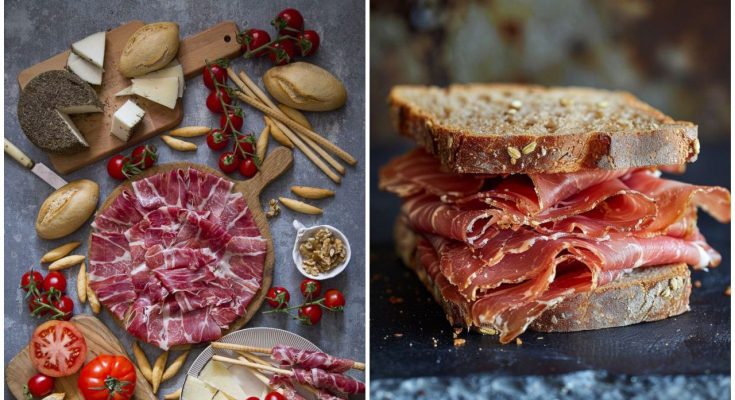Introduction
Jamón Ibérico is one of Spain’s most treasured culinary delights, renowned for its rich flavor, delicate marbling, and velvety texture. This cured ham, made from Iberian pigs, is a symbol of Spanish gastronomy and is often enjoyed during special occasions. While traditionally produced by master ham curers in Spain, with patience and the right techniques, you can experience the satisfaction of preparing and enjoying homemade Jamón Ibérico. This guide provides essential tips to help you achieve a perfectly cured ham and savor it at its best.
Understanding Jamón Ibérico
Jamón Ibérico comes from Iberian pigs, a breed native to the Iberian Peninsula. The quality of the ham is influenced by the pig’s diet, with the finest hams coming from pigs that have grazed on acorns, known as “bellota.” This diet gives the ham its unique flavor and buttery fat. The curing process can take anywhere from 12 to 48 months, depending on the desired intensity of flavor.
Choosing the Right Cut
When making Jamón Ibérico at home, start by selecting a high-quality Iberian pork leg. Look for the following:
- Bone-in leg: This is traditional for curing and helps maintain the ham’s shape and flavor during the curing process.
- Fat content: The fat should be well-marbled throughout the meat, which is essential for flavor and texture.
- Freshness: Ensure the pork leg is fresh and has been handled properly to avoid contamination during the curing process.
Essential Ingredients
To cure Jamón Ibérico at home, you’ll need the following ingredients:
- Sea salt: Use coarse sea salt, which draws moisture out of the meat and preserves it during the curing process.
- Optional spices: While traditional Jamón Ibérico is cured with just salt, some variations include mild spices like black pepper, garlic, or paprika for additional flavor.
- Aging environment: A cool, dry space with good ventilation is crucial for the curing process. Aim for a temperature between 50-60°F (10-15°C) and a humidity level around 70%.
Step-by-Step Curing Process
- Salting the Pork Leg
- Begin by covering the pork leg completely with sea salt. The general rule is to cure the ham for one day per kilogram of meat. Place the salted leg in a cool, dry place, and allow the salt to penetrate the meat fully.
- Removing Excess Salt
- After the salting period, remove the leg from the salt and rinse it under cold water to remove any excess salt. Pat the leg dry with clean towels.
- Drying Phase
- Hang the ham in a cool, ventilated space to dry. This phase lasts several weeks, during which the remaining moisture evaporates from the meat. The ham will begin to take on its distinct flavor and aroma.
- Aging and Curing
- The aging process is where the magic happens. Hang the ham in a curing room or a space with controlled temperature and humidity. This phase can last from 12 months to several years, depending on the desired flavor intensity. The longer the curing period, the richer and more complex the flavor.
- Checking for Doneness
- Periodically check the ham during the curing process. A well-cured Jamón Ibérico should be firm to the touch but still slightly yielding in the fat areas. The color should be a deep, rich red with marbled fat.
Serving and Enjoying Jamón Ibérico
After the curing process is complete, it’s time to enjoy the fruits of your labor. Here are some tips for serving and savoring your homemade Jamón Ibérico:
- Slicing Technique
- Use a sharp ham knife to slice the Jamón Ibérico thinly, starting at the hock and working your way toward the thicker part of the leg. The slices should be almost transparent, allowing the fat to melt in your mouth with each bite.
- Serving Suggestions
- Serve the Jamón Ibérico on its own to fully appreciate its flavor, or pair it with simple accompaniments like fresh bread, Manchego cheese, and a glass of Spanish red wine. The ham’s rich, savory taste also pairs beautifully with fresh figs, melon, or almonds.
- Storage Tips
- If not consuming all at once, wrap the cut portion of the ham in a clean, slightly damp cloth and store it in a cool, dry place. This will help maintain its flavor and texture for several weeks.
Conclusion
Making Jamón Ibérico at home is a rewarding process that allows you to connect with one of Spain’s most iconic culinary traditions. With careful attention to detail during the curing process and the right ingredients, you can create a perfectly cured ham that rivals those produced in Spain. Whether you’re serving it at a special gathering or enjoying it as a luxurious treat, homemade Jamón Ibérico offers a true taste of Spain’s rich gastronomic heritage.





